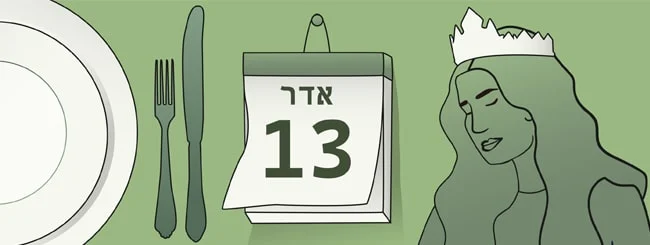10 Facts About the Fast of Esther Every Jew Should Know
From “Chabad.org Magazine” [email protected]

Art by Sefira Lightstone
The Fast of Esther, observed (the day) before Purim, commemorates the fasting of our ancestors in the Purim story. Read on for 10 facts about this solemn prelude to one of the happiest days on the Jewish calendar.
1. It Is One of Six Fasts
Of the six fasts in the Jewish calendar, four are associated with the conquest of Jerusalemand destruction of the Holy Temple: the Tenth of Tevet, the Seventeenth of Tammuz, Tishah B’Av, and the Fast of Gedalia. The other two are Yom Kippur and the Fast of Esther.
Read: Jewish Fast Days
2. It Is Kept One Day Before Purim (Sometimes Three)
In most years, the Fast of Esther is observed on 13 Adar, directly preceding the holiday of Purim on the 14th. When Purim occurs on Sunday (as it does this year—5784/2024), however, the fast is moved from Shabbat to the preceding Thursday.1 (It is not moved to Friday, to avoid greeting Shabbat on an empty stomach.2)
Read: The Fast of Esther
3. There Were Two Fasts in the Purim Story
The Fast of Esther commemorates the fast undertaken by the Jews in the Purim story on 13 Adar, 3405 (356 BCE), the day they defended themselves against their enemies. This act of fasting and prayer was intended as a means of initiating Divine mercy.3
Another period of fasting is also mentioned in the Purim story: Before approaching King Ahasuerus to plead for the Jewish people’s lives, Esther asked Mordecai to organize three days of fasting and prayer for Divine support in her perilous mission. Esther also committed to fasting alongside her attendants during this time.4
Some say these fasts serve as the basis for the Fast of Esther.5 Others disagree, pointing to the fact that these fasts took place in the month of Nisan, not Adar.6
Read: The Story of Queen Esther
4. Esther Gets the Credit
The name of the fast appears to be meaningful only if it commemorates the fasts requested by Queen Esther. But if it commemorates the fast undertaken before the battle, why is it associated specifically with Esther?
One resolution is that although the Jewish people wished to fast on 13 Adar, they could not actually do so because it would sap their strength and undermine their ability to fight. Instead, they vowed to fast on a later date.7 Esther, who spent that day in the safety of the royal palace, was the only one who actually fasted.8
Read: Why Is It Called the Fast of Esther?
5. It Begins at Daybreak
Unlike the fasts of Yom Kippur and Tisha B’Av which begin at sunset the previous night, the Fast of Esther starts at daybreak. Provided that you planned to wake up early for a snack, food and drink may be consumed throughout the night until dawn.
Read: Tips for an Easier Fast
6. Special Prayers Are Added
During the morning prayers, Selichot (penitential prayers) are recited, accompanied by the longer version of the Avinu Malkeinu prayer.
During the Amidah prayer of the afternoon service, those who are fasting add the paragraph of “Aneinu” in the Shema Koleinu blessing. (This prayer is also added in the cantor’s repetition of the Amidah—in both the morning and afternoon services—as its own blessing.) In years when the fast is not immediately followed by Purim, Avinu Malkeinu is said after afternoon services as well (since Tanachanun is said in that instance).
7. The Torah Is Read Twice
As on other fast days, the Torah is read twice, during the morning and afternoon prayers. Both readings discuss the aftermath of the Sin of the Golden Calf, where Mosessuccessfully interceded on the Israelites’ behalf and obtained forgiveness for their sin.9After the afternoon Torah reading, the special fast-day haftarah is also read.10
Read: The Torah Reading
8. Half Coins Are Given to Charity
In the times of the Holy Temple, every Jew would make an annual contribution of a half-shekel coin toward the purchase of communal sacrifices. These coins were generally collected in the month of Adar. In commemoration, before the afternoon service on the Fast of Esther, it is customary to give to charity three half coins of the standard local currency (e.g., three half dollars in the United States).11 This may also be done at a different time if necessary.
Read: Why Give Half Shekels to Charity on Taanit Esther?
9. You’re Usually Hungry When You Hear the Megillah
Most years, the fast is broken after the first Megillah reading, which takes place Purim night directly following the Fast of Esther. (The second reading takes place the next day.) The exception is when Purim is on Sunday, resulting in a two-day gap between the Fast of Esther and the Megillah readings.
10. It Merges Seriousness With Excitement
Fast days are days of repentance—opportunities to reflect on and improve our spiritual conduct. The Fast of Esther fuses these solemn sentiments with joy, as anticipation mounts for the festivities soon to follow. The difficulty of fasting is often barely felt due to Purim preoccupations: preparing matanot l’evyonim—financial aid for the poor; mishloach manot—gifts of food for friends and family; and the menu for the next day’s festive meal.
Read: How to Celebrate Purim
For more on this story go to: Chabad.org





